
Mission Statement:
"To advance through research, education and symposia, an increased public awareness of the Cape Fear region's unique history."

General William MacRae:
"Lee's Fighting Brigadier"
The Cape Fear Historical Institute Papers
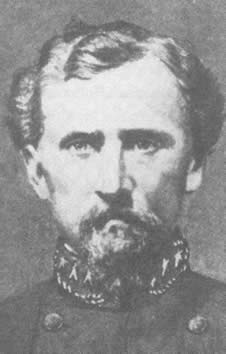
General William MacRae: Lee’s Fighting Brigadier
Gen. MacRae is one of five North Carolina men who called
Wilmington home and achieved the military rank of general.
Of the five, Generals Benjamin Smith, MacRae and
Loring fought to defend North Carolina and its
political independence.
Gen. William MacRae distinguished himself as one of
General Robert E. Lee’s brigadier’s in the Army of Northern
Virginia, leading his brigade until the final surrender
at Appomattox. He was a man of small physical stature
whose “high-pitched voice belied his solid fighting abilities.”
It was said that MacRae’s brigade was one of the best assault
units in Lee’s army, and Captain William Kenan wrote in
1899 that:
“under his leadership the highest degree of discipline and
proficiency was attained, for no position was considered too
strong to be assaulted if MacRae ordered it.” Author James
Sprunt describes MacRae as “a fine specimen of the material
that the Highlands have often given to North Carolina, a spare,
dark-visaged soldierly fellow---whose personal valor and
splendid handling of his troops in battle had caused him to be repeatedly complimented by Lee in general orders.”
Parentage:
William MacRae was the seventh of nine sons born to Alexander
MacRae of Wilmington, a man descended from the clan MacRae
from Rosshire on the coastal western highlands of Scotland. His
family members had fought with great valor in wars from the
Crusades to Waterloo.
Alexander was born in Cumberland County, North Carolina in
1796, son of Colin MacRae who died in 1807 at over ninety-years of
age and who is said to have perfectly embodied in his person
and manners the traditional idea of the Scotch Highlander.
So educated by his parents, Alexander MacRae was conversant
in Gaelic and possessed the Highlander traits to be passed on to his
sons. He married the daughter of Zilpah McClammy, mother
of William MacRae.
Alexander MacRae served in the War of 1812 and served long in
the North Carolina militia, being elected to major-general in the 1840’s.
He came to Wilmington in 1814 and found employment as a printing
office clerk, later became a successful commission merchant in
business with his brother Archibald, and contributed greatly to the establishment of the Wilmington and Weldon Railroad---
ultimately serving as its president.
In his seventh decade of life, Alexander MacRae as a Captain
and Major of North Carolina troops served at Forts Fisher and
Anderson, and fought at Bentonville in March of 1865---holding
the unique distinction of being the oldest Confederate officer.
Though born during Washington’s presidency, Alexander was to
live long enough to witness the end of the young American republic
presided over by that man---Alexander died in April 1868.
Early Life of William MacRae:
William MacRae was born on September 9, 1834 in Wilmington and
raised in an affluent atmosphere given his father’s successful businesses.
After receiving his early education in local academies and developed
an interest in railroads as a career. At age 16 he took employment with Morris & Company of Philadelphia and learned the trades of locomotive engineer and machinist. In 1855 he returned to Wilmington to work in the machine shops of the Wilmington and Weldon railroad where he served as
an engineer and track boss. He later studied civil engineering under his brother John and his father, and worked with them in North and South Carolina and Florida.
He was conducting surveys for the Carolina Central Railroad at Monroe,
North Carolina in April of 1861 when the Northern invasion began, and enlisted in the Monroe Light Infantry as a private. After this unit was mustered in as Company B of the 15th North Carolina Regiment in May, MacRae was elected its Captain. He would be joined in the defense of North Carolina by all but one of his eight brothers---one would desert his native State for the army of the enemy.
Military Service:
MacRae’s unit served first in Virginia but returned to North Carolina
to reinforce General Branch at Goldsboro after the Battle of New Bern.
He then was ordered back to Virginia with his regiment becoming
part of General Howell Cobb’s brigade, which was under
General John B. Magruder’s (later Lafayette McLaws)
division command, seeing action in the Peninsular and
Seven Day’s campaigns.
MacRae’s meritorious service earned him a promotion to Lieutenant
Colonel of the 15th North Carolina in April 1862. At the Battle of Sharpsburg he commanded the brigade, then reduced to only 250 men,
and repulsed three enemy assaults---withdrawing only after losing 200 casualties and exhausting his ammunition. MacRae’s regiment
participated at Fredericksburg and manned the breastworks
at Marye’s Heights; then his 15th North Carolina was transferred
to General John R. Cooke’s brigade of Tarheels to serve in southwest Virginia, being promoted to full colonel in February 1863.
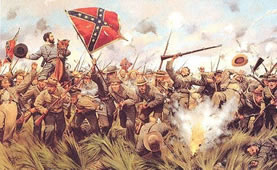
He rejoined Lee’s Army of Northern Virginia after its return from Gettysburg, earning great distinction for valor at the Battle of Bristoe
Station. He then assumed brigade command after the wounding of
General William W. Kirkland (of Hillsboro) at Cold Harbor in 1864---
with a temporary rank of brigadier general. Kirkland had served
previously as colonel of the 21st North Carolina, and had assumed
command of the brigade after the death of General James Johnston Pettigrew (of Washington County) in the aftermath of Gettysburg.
The brigade is known in War Between the States history as the
"Pettigrew-Kirkland-MacRae" brigade.
The new "MacRae" brigade now commanded consisted of the
11th, 26th, 44th, 47th and 52nd North Carolina Infantry regiments
which had already achieved fame under Pettigrew, but under
MacRae’s leadership they were to become an
exceptionally-disciplined fighting unit with a stern and able leader.
A Glorious Victory---The Battle of Ream’s Station:
On August 25, 1864, the three brigades of North Carolinians under
Generals Lane, Cook and MacRae were concentrated in a wooded area opposite the right flank of Northern forces. MacRae had told his men that
he knew they would go over the enemy works, and that he wished them
to do this without firing a gun. The artillery fire of (Col. William J.) Pegram swept the enemy forces before the brigades advanced late in the afternoon, charging up to the Northern earthworks and fighting hand to hand---ending with a full rout of the enemy. MacRae had instructed Lt. W.E. Kyle, and
his sharpshooters to concentrate upon the Northern artillery batteries firing
at his forces, thus eliminating this threat. Once captured, the guns were turned upon the fleeing enemy by Captain W.P. Oldham of Wilmington
and his men of Company K of the 44th North Carolina who opened an accurate and devastating fire.
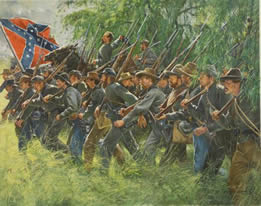
“In a moment of panic our troops gave way,” a Northern colonel
wrote (and) soldiers either threw themselves on the ground in
surrender or fled across the railroad. Never in the history of the
(Northern) Second Corps had such an exhibition of incapacity and
cowardice been given, a Northern soldier asserted. Author
James Robertson states in his “A.P. Hill, Story
of a Confederate Warrior”:
“of the 2700 (Northern) casualties, 2150 had surrendered on the
field…in addition, the (Northern) army had lost 9 cannon,
3100 small arms and 32 horses. (Northern General) Gibbon was
so humiliated by the rout at Ream’s Station that he submitted his
resignation from the army.”
Col. Pegram’s artillery battalion thought very highly of MacRae’s
brigade and felt that their guns could never be captured by the enemy
with MacRae supporting them. General Robert E. Lee publicly
and repeatedly stated that not only North Carolina, but he whole Confederacy, owed a debt of gratitude to Lane’s, Cook’s and
MacRae’s brigades which could never be repaid---and personally
wrote to Governor Zebulon Vance expressing his high
appreciation of their services. In his letter to Vance, Lee stated:
“If the men who remain in North Carolina share the spirit of
those they have sent to the field, as I doubt not they do, her
defense may securely be trusted to their hands.”
It is said that the great success of the assault at Ream’s Station was
largely the result of the keenness of MacRae in selecting the right
moment to strike at the enemy without awaiting orders to do so.
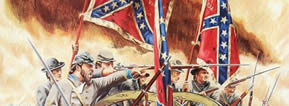
At his next major engagement with the enemy at Burgess’ Mill in October 1864, MacRae’s brigade once again displayed coolness and gallantry in battle. After an assault that broke the enemy line and captured an artillery battery, his brigade was left unsupported while an enemy counter-attack closed upon his flanks. A desperate struggle to hold his position ensued
until nightfall, when he fought through the new enemy lines that were
forming to his rear. His brigade entered that battle with 1,050 troops,
and all but 525 were casualties in the engagement.
MacRae would be elevated to permanent rank as a brigadier general through a special congressional law of October 1862, with this rank to
be effective November 4th. Though many times in exposed and
dangerous positions himself, MacRae suffered only one wound to
the jaw, though his uniform was pierced often by bullets and shrapnel.
His sabres suffered the most with two being cut in half by shots.
Though he lacked formal military training, MacRae was later
described as “one of the finest brigade commanders in Lee’s
Army of Northern Virginia” and a brilliant tactician knowing
when best to strike an enemy.
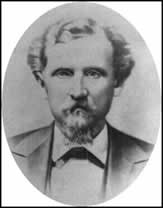
General MacRae and his brigade were not involved in the second
Battle of Hatcher’s Run of February 1865 in which several
Southern units severely suffered severe losses. General A.P. Hill
later recognized MacRae's value to his army and later testified that
“had William MacRae been here, the result would have been different.”
As his brigade retreated with Lee to Appomattox in April 1865,
MacRae's men fought off constant enemy attacks on Lee's precious
supply wagons. At the end, MacRae would be the last general,
and his unit the last brigade to stack arms during the surrender
proceedings on April 9th, 1865.
The final roll call would find 442 men left in his brigade.
As a testament to MacRaes's leadership, one of his own men stated:
“General MacRae, on being assigned to the brigade, changed the physical expression of the whole command in less than two weeks
and gave the men infinite faith in him and in themselves which was never lost, not even when they grounded arms at Appomattox."
Aftermath of War:
Returning a penniless former-brigadier general to Wilmington,
life-long bachelor William MacRae searched for employment in the
business he knew best---railroads.
He became general superintendent of the
Wilmington and Manchester Railroad in January 1866, bringing
it back from ruin to a fully-operating company; and later managed
the Macon and Brunswick line. He became general superintendent
of the Western and Atlantic Railroad in Georgia in 1873 and
eventually rose to Manager and Chief Engineer, though deteriorating
health would force him to resign and relocate to Florida in hopes of recuperation from overwork.
Convinced that his lung condition was worsening, MacRae determined
to return to Wilmington and await the end of his days, though still a
relatively young man at 47 years of age. He was visiting relatives in Augusta, Georgia on February 11, 1882 where “he was seized with congestive chill and died.” William MacRae’s remains were
conveyed to Wilmington where he was buried in Oakdale Cemetery
after services in St. James Church.
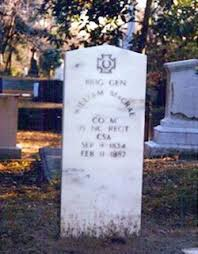
Major Charles M. Stedman on General MacRae’s Bravery:
MacRae’s life and military exploits were remembered in an 1890 Confederate Memorial Day address by former MacRae Brigade
member and Congressman (Major) Charles M. Stedman, delivered at
the Opera House (Thalian Hall) on Confederate Memorial Day in 1890. Major Stedman said of William MacRae that:
“nature had endowed him with a type of personal courage which
made him absolutely indifferent to danger, and this calmness amidst
a hurricane of shot, shell, and musketry was as great as when
seated at his breakfast table in his tent, or reviewing his command
at a dress parade. He made all around him brave. It mattered not
how appalling the fire, how terrific the storm of death, which swept
the field of battle, his presence always steadied the men,
who seemed to imbibe his spirit. I know no how to
characterize this quality unless it
be termed the “mesmerism of bravery.”
Sources:
General A. P. Hill, James I. Robertson, Random House, 1987
Dictionary of North Carolina Biography, W. Powell, UNC Press, 1986
Chronicles of the Cape Fear, James Sprunt, 1916
Confederate Military History, Vol. IV, Blue & Grey Press 1983
Confederate Veteran Magazine, September 1899, pp. 397-398
©2006 Cape Fear Historical Institute